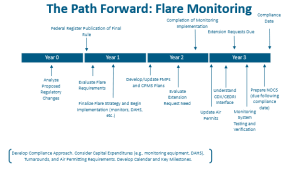The Early Bird Gets the Worm: Preparing for Enhanced Flare Monitoring in the Chemical Sector
Posted: October 31st, 2023
Authors: Katie F.
In case you haven’t heard yet, the U.S. Environmental Protection agency (U.S. EPA) has proposed revisions to the National Emission Standards for Hazardous Air Pollutants (NESHAP) and New Source Performance Standards (NSPS) applicable to facilities in the Synthetic Organic Chemical Manufacturing Industry (SOCMI) and Group I and II Polymers and Resins (P&R) Industries. Check out ALL4’s previous blogs for a summary of the broader changes. This article is going to focus on a smaller chunk of those revisions, specifically, getting your facility ready to implement the proposed changes to the flare monitoring requirements in 40 CFR Part 63 Subparts F, G, H, and I (HON) and Subpart U (P&R Group I).
If there’s one thing we’ve learned from implementing changes to flare monitoring from the Refinery Sector Rules – it’s never too early to start planning ahead! The sooner you finalize your facility’s flare strategy and begin implementation of the monitoring systems, the better off you’ll be.
But where do I start?
Good question. There are many items to consider when developing a flare strategy, but a few of the most important pieces include:
- Are the new rule requirements different from my permit or my consent decree?
- What monitoring technology will be best suited for your operations?
- Will your facility’s data acquisition and handling system (DAHS) need upgrades/additional configuration to be able to demonstrate ongoing compliance?
- Do you have the resources needed for a robust quality assurance and quality control (QAQC) program?
- How will you comply with the recordkeeping and reporting requirements?
Great, but I have time, right?
ALL4 has participated in several successful flare monitoring projects from the initial flare strategy planning all the way through implementation and verification of the monitoring systems. In our experience, this process can take 2-3 years on average to successfully complete. Take a look at the timeline below – there’s a lot to fit in!
An important piece that may be easy to overlook is building in the time necessary for testing and troubleshooting prior to the compliance date. You’ll want to plan for a period of time to allow the monitoring systems to collect data, the DAHS to handle and report the data, and the environmental and operational staff to review and evaluate the data and monitoring systems.
If you have questions or would like to discuss approaches for upgrading your flare monitoring programs, please reach out to me at kfritz@all4inc.com or 610-422-1116. We will also be hosting a complimentary in-person workshop for members of industry in Lake Charles, LA on November 8, 2023, to provide an overview of the proposed changes and will touch on flare monitoring impacts. ALL4 is monitoring all updates published by the U.S. EPA on this topic, and we are here to answer your questions and assist your facility with any aspects of environmental regulatory compliance.


